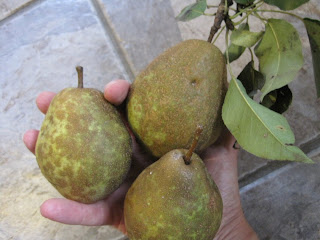 My parents gave me a 1/2 bushel of pears, because it's fruit harvest season, here on the east coast! You might remember that I also got a slew of apples. I've made apple crisp, apple pie, apple sauce, stewed apples, apple muffins...later, if I remember, I'll share the list.
My parents gave me a 1/2 bushel of pears, because it's fruit harvest season, here on the east coast! You might remember that I also got a slew of apples. I've made apple crisp, apple pie, apple sauce, stewed apples, apple muffins...later, if I remember, I'll share the list. But this is not about apples. It's about pears.
Last night, I made a pear and apple pie. For the first time in my life, I discovered the joy of making a pie crust using a food processor. The food processor that Nick and I have is a "Magimix", which we bought in 1986, while living in Germany. The Magimix is a ProtoCuisinart. Ours is a 220 volter, made for Europe, and it's fully equipped with a recipe book "en Francais, s'il vous plait"! And I still use this Magimix, over 20 years later.
I used it to make the crust.
2 cups flour
1 teaspoon salt
1 tablespoon sugar
1 stick butter
2 tablespoons crisco
put all this in the food processor, with the metal blade, and pulse about 6 times.
Then, add about 1/2 cup water, iced. Pulse again, a few times, and there is a beautiful, hands-free pie crust dough! This recipe is adapted from Julia Child.
I put it in the refrigerator for 1/2 hour before rolling it out.

This pie...only took half the above recipe, as I put a crumb crust on top, decorated, of course with an apple cutout, drawn freehand. The remainder is in the refrigerator, for later use. Pie crust, if wrapped well, will keep for weeks at a time. I learned this from the Pillsbury people, who sell 'ready made' pie crust in the grocery store. I don't buy that very often...and after discovering the joys of food processor dough, I won't in the future, at all!
After baked, this dough was light, crispy, and perfect for a fruit pie.
So, for inquiring minds, here's what I did for the filling:
6 cups more or less of mixed pears and apples, cored, peeled, and sliced
1 tablespoon cinnamon
1/2 tsp nutmeg
1/2 cup sugar
2 tablespoons flour
1 tablespoon lemon juice
1/2 cup flour
Mix the above all together, and put in the rolled out pie crust.
Top with crumb topping:
1/2 cup flour
1/2 cup oats
1/2 cup brown sugar
1 tablespoon cinnamon
mix in 2 tablespoons butter until crumbly
Bake at 350 degrees F. until done. This is when the crust looks crisp, the pie is bubbling, and your nose...well...it just "knows"...that the baking is done.
The pie you see is ready for transport to a friend's house for dinner! We served it with homemade ice cream.





